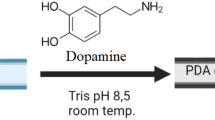Abstract
The popularity of polyethylene terephthalate (PET) as a polymer substrate for flexible electronics has lately increased. The interaction between conductive inks and substrates is crucial. The high surface tension and poor surface wettability provide challenges when using conductive ink on PET substrates. To increase its adherence and compatibility with conductive inks, surface treatment is required. This paper describes how the PET substrate is hydrolyzed using sodium hydroxide (NaOH) to cause surface erosion. The treatment was carried out by adjusting the NaOH concentration and hydrolysis duration. The findings supported the increase in wettability after treatment as the water contact angle decreased from 78.60º (untreated PET substrate) to 39.90º (maximum). Fourier transform infrared spectroscopy identified an O–H group in the PET as a change in surface chemistry. Additionally, the hydrolysis in a 10 M NaOH solution showed the best improvement in wettability.
Access this chapter
Tax calculation will be finalised at checkout
Purchases are for personal use only
Similar content being viewed by others
References
Yang W, Wang C, Arrighi V (2018) Silver oxalate ink with low sintering temperature and good electrical property. J Electron Mater 47(5):2824–2835
Rivadeneyra A, Loghin F, Falco A (2018) Technological integration. In: Printed electronics, in flexible electronics. IntechOpen
Wu W (2019) Stretchable electronics: functional materials, fabrication strategies and applications. Sci Technol Adv Mater 20(1):187–224
Aydemir C, Altay BN, Aykol M (2021) Surface analysis of polymer films for wettability and ink adhesion. Color Res Appl 46(2):489–499
Wieszczycka K et al (2021) Surface functionalization–The way for advanced applications of smart materials. Coord Chem Rev 436:213846
Liu XD et al (2013) UV-assisted surface modification of PET fiber for adhesion improvement. Appl Surf Sci 264:61–69
**ao S et al (2017) Layer-by-layer assembly of polyelectrolyte multilayer onto PET fabric for highly tunable dyeing with water soluble dyestuffs. Polymers 9(12):735
Vesel A et al (2020) Evolution of the surface wettability of PET polymer upon treatment with an atmospheric-pressure plasma jet. Polymers 12(1):87
Donelli I et al (2010) Surface structure and properties of poly-(ethylene terephthalate) hydrolyzed by alkali and cutinase. Polym Degrad Stab 95(9):1542–1550
Prorokova N et al (2014) Chemical method of fibrous materials surface activation on the basis of polyethylene terephthalate (PET). Ch&ChT 8(3):293–302
Adina C et al (2017) Alkaline hydrolysis of polyethylene terephthalate under microwave irradiation. Rev Roum Chim 62:531–538
Acknowledgement
We are very grateful to the Ministry of Higher Education Malaysia for awarding us a Fundamental Research Grant Scheme (FRGS/1/2021/TK0/USM/01/4) and Universiti Sains Malaysia for making this study possible.
Author information
Authors and Affiliations
Corresponding author
Editor information
Editors and Affiliations
Rights and permissions
Copyright information
© 2023 The Author(s), under exclusive license to Springer Nature Singapore Pte Ltd.
About this paper
Cite this paper
Ibrahim, N., Jaafar, M. (2023). Surface Treatment of Polyethylene Terephthalate Substrate by Sodium Hydroxide. In: Maleque, M.A., Ahmad Azhar, A.Z., Sarifuddin, N., Syed Shaharuddin, S.I., Mohd Ali, A., Abdul Halim, N.F.H. (eds) Proceeding of 5th International Conference on Advances in Manufacturing and Materials Engineering. Lecture Notes in Mechanical Engineering. Springer, Singapore. https://doi.org/10.1007/978-981-19-9509-5_40
Download citation
DOI: https://doi.org/10.1007/978-981-19-9509-5_40
Published:
Publisher Name: Springer, Singapore
Print ISBN: 978-981-19-9508-8
Online ISBN: 978-981-19-9509-5
eBook Packages: EngineeringEngineering (R0)




